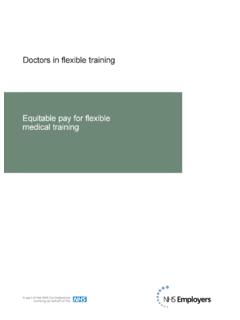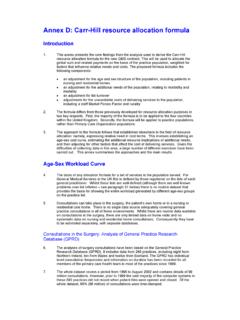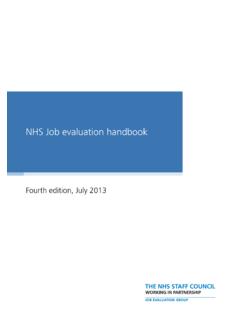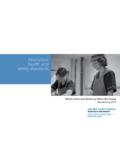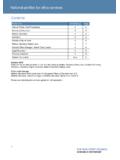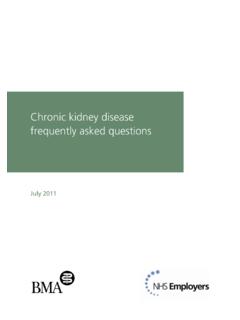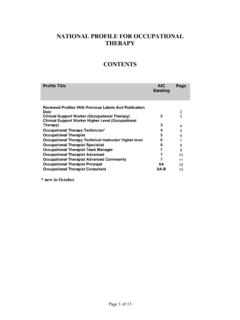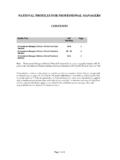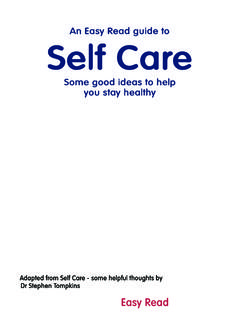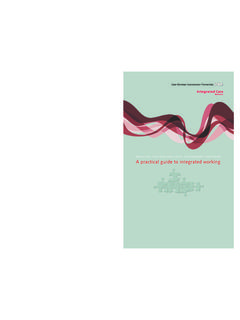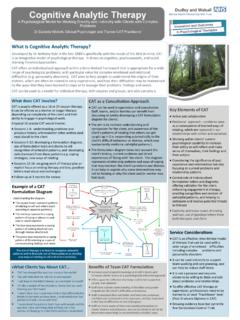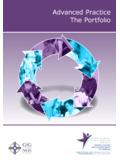Transcription of Electronic rostering: helping to improve workforce ...
1 October 2007 Electronic rostering: helping toimprove workforce productivityA guide to implementing electronicrostering in your workplace2 About this guide3 Introduction4 What is Electronic rostering?5 Why Electronic rostering is important in today s NHS6 How can Electronic rostering help my trust to be more productive?7 Flexible working options7 Greater control and less administration7 Electronic Staff Record (ESR)8 Work-life balance needs for staff9 Fair and open rostering9 Sustained savings for trusts10 Improved payroll accuracy10 How do I get e-rostering working in my trust?11 Key factors13 Trust rostering policy15 Top tips for implementing an e-rostering system16 Available Electronic rostering systems18 Conclusion19 Further information19 Contents3 We have been implementing our e-roster programme since April 2007 this guide would havebeen invaluable when looking to select a provider and solution for our trust!
2 Implementing e-rostering is neither easy or a small piece of work but hard work pays off and we are startingto enjoy the benefits from it. Mark ElmoreDeputy Director of Human ResourcesIsle of Wight NHS PCT This guide is invaluable! It provides trust boards and clinical areas with the information theyneed to successfully implement an Electronic rostering system that will help trusts deliver costsavings and improve productivity. Lyn McIntyreAssistant Chief NurseCambridge University Hospitals NHS Foundation Trust We are currently live with the bank and self rostering on 13 wards. It would have been veryuseful to have had this guide to support the business case presented to our trust board prior toapproval. Although we have covered most of the content ourselves there is still someinformation even now, that is current and useful. Maria StoneRecruitment and Retention ManagerSouth Devon Healthcare NHS Foundation Trust This provides an excellent framework for trusts implementing Electronic rostering to work to,and should help shortcut the process.
3 Rob FontaineBusiness Manager Operations and Nursing DirectorateWalsall Hospitals NHS TrustAbout this guide41 Getting the best from temporary nursing staff. Audit Commission, 5 September 20012 Admin and clerical, allied health professionals, estates and ancillary, healthcare scientists, medical and dental,nursing and midwifery, scientific and technical and other clinical costs account for 75 per cent of NHS running costs. How those staff are rostered and howtheir time is managed can have a significant impact on trust expenditure. Since 2001, when theAudit Commission first highlighted concerns about the high costs associated with temporarybank and agency staff1, much progress has been made with using these staff more , in 2006 the National Audit Office found that few trusts were using electronicrostering systems and recommended them as a way to help control demand for temporarystaff, optimise the use of permanent staff, and reduce overhead costs through integration withpayroll Employers carried out an evaluation exercise in February 2007 to assess a number ofelectronic rostering systems currently available on the market and recommends that trustsconsider implementing Electronic rostering as part of their overall strategy to improve guide highlights the productivity benefits of using Electronic rostering systems to roster allstaff groups2.
4 And to provide trusts with key information that will enable them to choose andthen successfully implement an Electronic rostering system. It is aimed at boards, chiefexecutives, human resources directors, medical directors, nursing directors, and any othersinterested in improving the productivity of their is Electronic rostering? Electronic rostering (or e-rostering) is simply an Electronic way of efficiently managing whenstaff are needed to work. There are a number of e-rostering systems on the market that can beintegrated into trusts existing human resource information systems. While they all havedifferent features and pricing structures, the basic concept behind them remains the rostering systems enable managers to quickly build their rosters, defining the numberof employees (by skill-mix) needed to meet the demands of the NHS.
5 Employees can rosterthemselves to work within the slots defined. The line manager confirms their attendance,ensuring that pay accurately reflects the work done. Widely used in both the private and publicsectors, e-rostering is now also being used in several NHS trusts, and many of them are alreadyfinding it improves productivity and makes significant savings through better management oftheir substantive and temporary workforces. It also enables trusts to manage their workforcemore flexibly, and to make it easier for employees to choose a better work-life NHS in England and Wales now has a fully integrated human resource information system, Electronic Staff Record (ESR), which has been designed to work with e-rostering systems. Bycombining the two systems, trusts can now manage their workforce flexibly and cost effectivelyto meet patient needs, whilst reducing payroll administration costs, and increasing the accuracyof payroll ESR interface team has worked with many third party suppliers over the last 12 months toassist them in developing their products to make use of these interfaces.
6 More details on someof the different suppliers can be found on page Electronic rostering is important in today s NHS63 NHS workforce : staff in the NHS 1996 2006. NHS Information Centre, 26 April 20074 workforce planning. p3 (summary). House of Commons Health Committee, Fourth Report of session 2006 07,volume 1, 22 March 2007 (HC 171-I)5 Department of Health: improving the use of temporary nursing staff in NHS acute and foundation trusts, p5. Houseof Commons Committee of Public Accounts. 29th Report of session 2006 07, 14 May 2007 NHS leaders need to use resources (people, technology, buildings) more flexibly and efficiently inorder to provide new and better ways of delivering healthcare that meet the needs of improving the way NHS employees are managed through better rostering, greater value canbe released from all resources so that better care is provided to 2006, the NHS had a workforce of million3.
7 Lots of staff doing complex work in a rapidlychanging healthcare market requires the NHS to have managers with the skills to produceefficient and effective work rosters and to plan their workforce to serve patients in the mostproductive way. The workforce configuration (skill mix) will need to be responsive to the keydrivers of change over the next 20 years: the post-war baby boom will mean that the healthcare population aged 65 and overwill have increased by around 22 per cent, those over 85 will have increased by 26per cent over the next 20 years new advances in medical technology are producing new treatments that are turningfatal diseases into treatable conditions rising levels of obesity will increase pressures on the health system the current birth rate is up 10 per cent (to a new 25 year high) part-time working and other flexible working patterns are going to be increasinglypopular to modern family life.
8 Employers will need to consider this as part of theirrecruitment and retention strategy new health and social care partnerships and new types of commissioning will requiremore effective people need to be more effective at workforce rostering should aim to deliverincreased productivity by helping managers control resources effectively to meet patientdemand. The Public Accounts Committee criticised trusts in 2007 for not taking a strategicand managed approach to controlling demand for temporary nursing 5, and recommended that ..strategy should be underpinned by a clear understanding of the requisite establishmentlevels needed to provide safe and effective care, which IT-based workforce management androstering systems could help determine. How can e-rostering help my trust to bemore productive?7 Flexible working optionsE-rostering systems enable managers to improve the way their most valuable resource ismanaged their people.
9 Managers design their rosters, by taking account of the needs of theNHS first. This can include, if appropriate, patient demand. The number of staff needed by skillmix is then defined by time of day, and managers can allow their staff to self roster online. A good e-rostering system will allow staff to request the times they prefer to work, whilstensuring that working and time off rules are key benefit of e-rostering is supporting managers to match the right people skills to meetpatient demand. Managers have better control to end over-staffed wards when there is minimaldemand, and to avoid under-staffed and unsafe wards when patient demand is high. It s alsoeasier for managers to arrange cross cover across wards or healthcare systems make it easy for employees to request when they would like to work theircontracted hours. Managers are more empowered to use their workforce more effectively interms of controlling costs and improving the quality of patient care and the experience ability of e-rostering to support flexible working can result in increased attendance ratesand a reduction in short-term sickness.
10 It can also help reduce staff turnover. By retainingtalented staff, recruitment and induction costs are therefore minimised, as are demands fortemporary staffing cover. Better staff management clearly has a direct effect on delivering goodpatient control and less administrationE-rostering releases significant administrative time and enables managers to be more example, a typical experienced nurse manager would normally be expected to spend aboutthree days each month to roster their staff. E-rostering can do this task in about three of wards and departments can therefore use their time more productively caring forpatients and developing their important benefit of e-rostering is that it enables budget holders to have greatercontrol and flexibility over how they use and keep within their funded establishment (overallstaffing budget).

